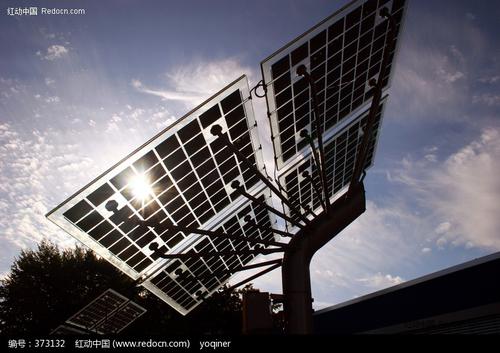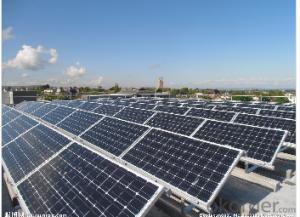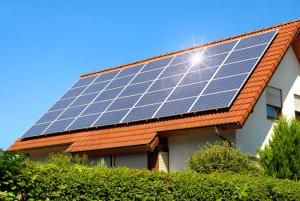Poly Solar Panel 01 Clips for Solar Panels
- Loading Port:
- China Main Port
- Payment Terms:
- TT OR LC
- Min Order Qty:
- -
- Supply Capability:
- -
OKorder Service Pledge
OKorder Financial Service
You Might Also Like
Solar Module
ABOUT YINGLI GREEN ENERGY
Yingli Green Energy Holding Company Limited (NYSE: YGE) is one of
the world’s largest fully vertically integrated PV manufacturers, which
markets its products under the brand “Yingli Solar“. With over 7.0GW
of modules installed globally, we are a leading solar energy company
built upon proven product reliability and sustainable performance. We
are the fi rst renewable energy company and the fi rst Chinese company
to sponsor the FIFA World CupTM.
PERFORMANCE
- High effi ciency, multicrystalline silicon solar cells with high transmission
and textured glass deliver a module effi ciency of up to 16.0%,
minimizing installation costs and maximizing the kWh output of your
system per unit area.
- Tight positive power tolerance of 0W to +5W ensures you receive
modules at or above nameplate power and contributes to minimizing
module mismatch losses leading to improved system yield.
- Top ranking in the “TÜV Rheinland Energy Yield Test” and the
“PHOTON Test” demonstrates high performance and annual energy
production.
RELIABILITY
- Tests by independent laboratories prove that Yingli Solar modules:
Fully conform to certifi cation and regulatory standards.
Withstand wind loads of up to 2.4kPa and snow loads of up to
5.4kPa, confi rming mechanical stability.
Successfully endure ammonia and salt-mist exposure at the highest
severity level, ensuring their performance in adverse conditions.
- Manufacturing facility certifi ed by TÜV Rheinland to ISO 9001:2008,
ISO 14001:2004 and BS OHSAS 18001:2007.
WARRANTIES
- 10-year limited product warranty1.
- Limited power warranty1: 10 years at 91.2% of the minimal rated power
output, 25 years at 80.7% of the minimal rated power output.
1In compliance with our Warranty Terms and Conditions.
QUALIFICATIONS & CERTIFICATES
IEC 61215, IEC 61730, MCS, CE, ISO 9001:2008, ISO 14001:2004, BS OHSAS
18001:2007, PV Cycle, SA 8000
ELECTRICAL PERFORMANCE
Electrical parameters at Standard Test Conditions (STC)
Module type YLxxxP-29b (xxx=Pmax)
Power output Pmax W 260 255 250 245 240
Power output tolerances ΔPmax W 0 / + 5
Module effi ciency ηm % 16.0 15.7 15.4 15.1 14.8
Voltage at Pmax Vmpp V 30.3 30.0 29.8 29.6 29.3
Current at Pmax Impp A 8.59 8.49 8.39 8.28 8.18
Open-circuit voltage Voc V 37.7 37.7 37.6 37.5 37.5
Short-circuit current Isc A 9.09 9.01 8.92 8.83 8.75
Electrical parameters at Nominal Operating Cell Temperature (NOCT)
Power output Pmax W 189.7 186.0 182.4 178.7 175.1
Voltage at Pmax Vmpp V 27.6 27.4 27.2 27.0 26.8
Current at Pmax Impp A 6.87 6.79 6.71 6.62 6.54
Open-circuit voltage Voc V 34.8 34.8 34.7 34.6 34.6
Short-circuit current Isc A 7.35 7.28 7.21 7.14 7.07
STC: 1000W/m2 irradiance, 25°C cell temperature, AM1.5g spectrum according to EN 60904-3.
Average relative effi ciency reduction of 3.3% at 200W/m2 according to EN 60904-1.
NOCT: open-circuit module operation temperature at 800W/m2 irradiance, 20°C ambient temperature, 1m/s wind speed.
OPERATING CONDITIONS
Max. system voltage 1000VDC
Max. series fuse rating 15A
Limiting reverse current 15A
Operating temperature range -40°C to 85°C
Max. static load, front (e.g., snow) 5400Pa
Max. static load, back (e.g., wind) 2400Pa
Max. hailstone impact (diameter / velocity) 25mm / 23m/s
CONSTRUCTION MATERIALS
Front cover (material / thickness) low-iron tempered glass / 3.2mm
Cell (quantity / material / dimensions /
number of busbars)
60 / multicrystalline silicon / 156mm x 156mm / 2 or 3
Encapsulant (material) ethylene vinyl acetate (EVA)
Frame (material / color / anodization color /
edge sealing) anodized aluminum alloy / silver / clear / silicone or tape
Junction box (protection degree) ≥ IP65
Cable (length / cross-sectional area) 1000mm / 4mm2
Plug connector
(type / protection degree) MC4 / IP67 or YT08-1 / IP67 or Amphenol H4 / IP68
PACKAGING SPECIFICATIONS
Number of modules per pallet 29
Number of pallets per 40' container 28
Packaging box dimensions
(L / W / H) 1700mm / 1135mm / 1165mm
Box weight 568kg
Unit: mm
• Due to continuous innovation, research and product improvement, the specifi cations in this product information sheet are subject to change
without prior notice. The specifi cations may deviate slightly and are not guaranteed.
• The data do not refer to a single module and they are not part of the offer, they only serve for comparison to different module types
- Q: do solar panels create electricity from the ultraviolet light created from the sun? because they only have an efficientcy of like 8% and this scientist found out a way to collect the visible light also, and he says the solar panel could have an effeciency of up to 80%! so my question really is, do solar penels creat electricity from heat? do you know of anything that can?
- Solar panels create a current from light. A photon strikes a crystal lattice and anelectron is freed and flows as a current
- Q: im trying to run my house with with solar panels, is it possible? if so please let me know how....i have a 6000 w inverter
- It is not feasible to do everything with solar panels. However, if you overproduce during the day and sell the excess to the power company, you might be able to [pay for what you have to buy from them. Another thing you can do is use renewable energy in other forms, with windmills, hydraulic rams, and trombe walls.
- Q: Can solar panels be installed in areas with high levels of air pollution?
- Yes, solar panels can be installed in areas with high levels of air pollution. While air pollution can potentially have a slight impact on the efficiency of solar panels, it is not a significant barrier to their installation and operation. Solar panels primarily rely on sunlight, which is still present even in polluted areas. Additionally, solar panels can even contribute to reducing air pollution by providing clean energy alternatives.
- Q: How do solar panels affect the insurance premiums of a home?
- Solar panels can potentially have a positive impact on home insurance premiums. While the initial installation cost of solar panels may increase the value of a home, they can also lower the risk of fire damage and reduce reliance on the grid. As a result, some insurance companies offer discounts or special policies for homes with solar panels, which may lead to lower insurance premiums in the long run. However, it is important to consult with individual insurance providers as policies can vary.
- Q: Since plants have been populating this earth for the past 475 million years I think they have evolved to gain the most sun with their greenery. If scientists used heat sensors to find the hot spots of trees and trim all of the leaves that don't quot;providefor the plant, then maybe that trimmed tree could be used to become a solar quot;panelquot;. I believe that each individual leaf could be replaced by a small solar panel and the wood of the tree would be wiring that would root all of the solar panels to a generator.
- From the vantage point of a scientist and an engineer, you have a whole host of problems to overcome. The mass of solar cells cannot be supported by most leaves much less allow the leaves to turn toward the sun as they naturally do. The wood and other structures of a tree are terrible conductors and wouldn't serve as efficient power transmitters. There are issues of damaging the health of the tree by interrupting the process of photosynthesis in favor of solar energy collection, and many other issues. However, I can tell you that solar power does use several principals that you have observed in trees. For example, solar collectors are almost always oriented to face toward the sun. Many adjust with the time of day and seasons to be optimally oriented to collect the sun's rays. Much like leaves in many plants are not static but change position to optimize their angle to the sun. Also, many solar cells are now designed with a membrane structure which offer several advantages. So you see many of your observations have found their way into practical application in solar power production.
- Q: Can solar panels be used in multi-story buildings?
- Yes, solar panels can be used in multi-story buildings. They can be installed on rooftops or other suitable areas to generate renewable energy for the building.
- Q: Can solar panels be installed on train stations?
- Yes, solar panels can be installed on train stations. In fact, many train stations around the world are adopting solar energy systems to power their operations and reduce their carbon footprint. Solar panels are installed on the roofs or canopies of train stations to harness sunlight and generate electricity, which can be used for lighting, heating, cooling, and other station facilities. This renewable energy source makes train stations more sustainable and helps in the transition towards a greener transportation system.
- Q: Are solar panels noisy?
- No, solar panels are not noisy. They do not have any moving parts and therefore, do not produce any noise while generating electricity from the sun.
- Q: I was thinking about getting some GE Solar Panels and on there website that I am on, I didn't really see a price. can anybody give me maybe an estimate on how much each one would cost? thanks
- I wasn't aware that GE made solar panels. Perhaps they sold their name to someone, as they've done for all of their consumer electronics. But a 90-watt panel is $66.20 from the place below.
- Q: So I reckon it's time to install some of these bad boys. it's come to point where electricity providers are charging such extortionate amounts that I can definitely see these reaping huge rewards before long. (Okay I might be exaggerating a little - they are pretty costly themselves).The problem is I've read around that they're only fitted to south facing houses? Why so? Why can't they be installed on the rear side of the roof - the side facing the garden? My house is facing north, so the front door leads north. Could I have solar panels installed on the back? (That's basically my question, with a bit of a rant too lol).Cheers.
- You want the panels facing south because that is where they would get the most sunlight throughout the day. If your front door is facing north, then the back of your house would be facing south, right? So put them up in the back where they are facing south...haha wtf..
Send your message to us
Poly Solar Panel 01 Clips for Solar Panels
- Loading Port:
- China Main Port
- Payment Terms:
- TT OR LC
- Min Order Qty:
- -
- Supply Capability:
- -
OKorder Service Pledge
OKorder Financial Service
Similar products
Hot products
Hot Searches
Related keywords




















